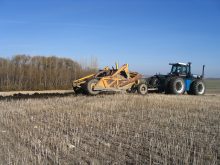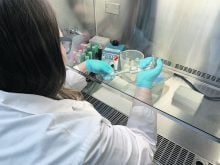Crop protection products built with RNA, a nucleic acid present in all living cells, have shown promise in both lab and field conditions.
But the high cost to produce RNA is a significant hurdle for this emerging technology.
That is why GreenLight Biosciences decided to focus its resources on developing a new RNA production process and facility in Rochester, New York, to help get new modes of action into farmers’ hands.
RNA is typically produced in batches too small and expensive for the volumes needed in agricultural applications. To get around this problem, several companies are trying to create RNA through fermentation.
Read Also

More work wanted on removing red tape
REGINA — Canadian farmers risk falling further behind competitors if two main federal agencies don’t become more efficient and responsive…
This production method is hard to manage because it’s difficult to filter out impurities and maintain a high-quality end product at scale.
GreenLight Biosciences designed a process that takes leftover yeast from beer production and breaks it down with enzymes into the fundamental components of RNA.
The material is then energized, with an old style of water softener and phosphorus, and reassembled into pure RNA. Key components of the procedure are enzymes that were harvested near volcanic vents in the Arctic Ocean.
Researchers looked there because RNA is closely related to the beginning of life on Earth, and this environment is close to where life likely originated.
Catie Lee is the marketing director at GreenLight Biosciences. She said the new production process is housed at Rochester, in a former Eastman Kodak facility.
“We built a pilot plant there to kind of get us through our first year of operation. We have plans, when the time is right, to expand that footprint to be able to power the production for everything in our pipeline.”
GreenLight has already developed pesticides and fungicides that may see regulatory approval in the United States as soon as 2023.
Lee said RNA-based products are a good fit within agriculture for several reasons, including residual concerns about traditional products. There are also few new modes of action being introduced to address growing resistance in pests to existing products.
“Then you compound that all with additional regulation, primarily being driven out of the EU. But we’re seeing it more and more beyond there as well, here in the States in California, and I think you’re experiencing it in Canada as well. So, what that means is that you’ve got a market primed for new technology and that’s where RNA comes in,” Lee said.
COVID-19 vaccinations from Pfizer and Moderna use some of the same principles as those used in RNA-based agricultural products.
“We know that mRNA can be designed to be specific to certain variants. We have the initial Delta version, then Omicron, now bivalent (vaccinations). The same sort of principle applies here, where we can design products to be very specific to a target species. What that means is that we can be thoughtful about off-target effects,” Lee said.
The first product GreenLight is bringing to market is a dsRNA pesticide that causes the Colorado potato beetle to stop eating and expire from its own toxins.
“Our first product, Calantha, is a really good example of a new product, a new mode of action. So, it works against Colorado potato beetle in a different way than other products in the market, which means that there is no current resistance out there on the on farm.”
Calantha is a foliar-applied dsRNA pesticide that protects potatoes against the beetle, which has developed resistance to many chemical-based products. It is mixed with water and sprayed using standard practices.
A key advantage of dsRNA pesticides over traditional crop protection products is how targeted they can be, and how little impact they can have on off-target species.
“Our testing has shown that our Colorado potato beetle product is safe for honeybees, butterflies, and several other nontarget insects and mammals at use rates 100 times higher than our recommended rate. It degrades in water and soil within three days to benign, natural nucleotides,” Lee said.
“It controls all stages of the life of this beetle but is most effective on young larvae up to one-quarter inch in length. We aim to launch our product to tackle the US$350 million market for protecting crops from the beetle. We have filed for EPA approval, and sales would take place ahead of the following growing season.”
A little further down GreenLight’s product pipeline is a solution for honeybees that targets varroa mite. The firm completed a tier-two toxicity study to satisfy the data requirements needed under EPA guidance, and expects to apply for regulatory approval in 2023.
GreenLight is also conducting field trials for additional products for botrytis fungus, diamondback moth and powdery mildew, and is also working on an RNA-based solution for fall armyworm and fusarium head blight.
“We are looking at targeting both the control of fusarium head blight itself, but I think one thing that is exciting me in particular is the opportunity to potentially control some of the DON as well,” Lee said, referring to toxins produced by fusarium head blight.
“There aren’t too many products out there that do a great job of DON reduction right now. So really, it’s a pain point that we’ve heard from growers and we’ve got some early indications of success … that we are looking to translate to field level right now.”
The fusarium-control product will be a dsRNA foliar-applied product and GreenLight plans to ramp up research on the best time to apply it.
“You need enough mass in the spikelets to kind of have the surface area to work. So, it’s most likely to be a mid to late season application. But these are the types of questions that we ask in product development.”
The new RNA production facility allows GreenLight to conduct field trials on new products.
Previously, there was a more limited amount of the base RNA material to work with, so researchers had to be more stringent in the development program.
Lee said GreenLight has rapidly increased the number of collaborators in the scientific and business community since the new RNA production facility came online, because it can now supply new partners with RNA material.
When it comes to the regulatory environment in Canada and beyond, Lee said the company is working to educate authorities on the new technology.
GreenLight is also developing RNA-based products for the human health market, including messenger RNA vaccines for COVID-19 and shingles.


















